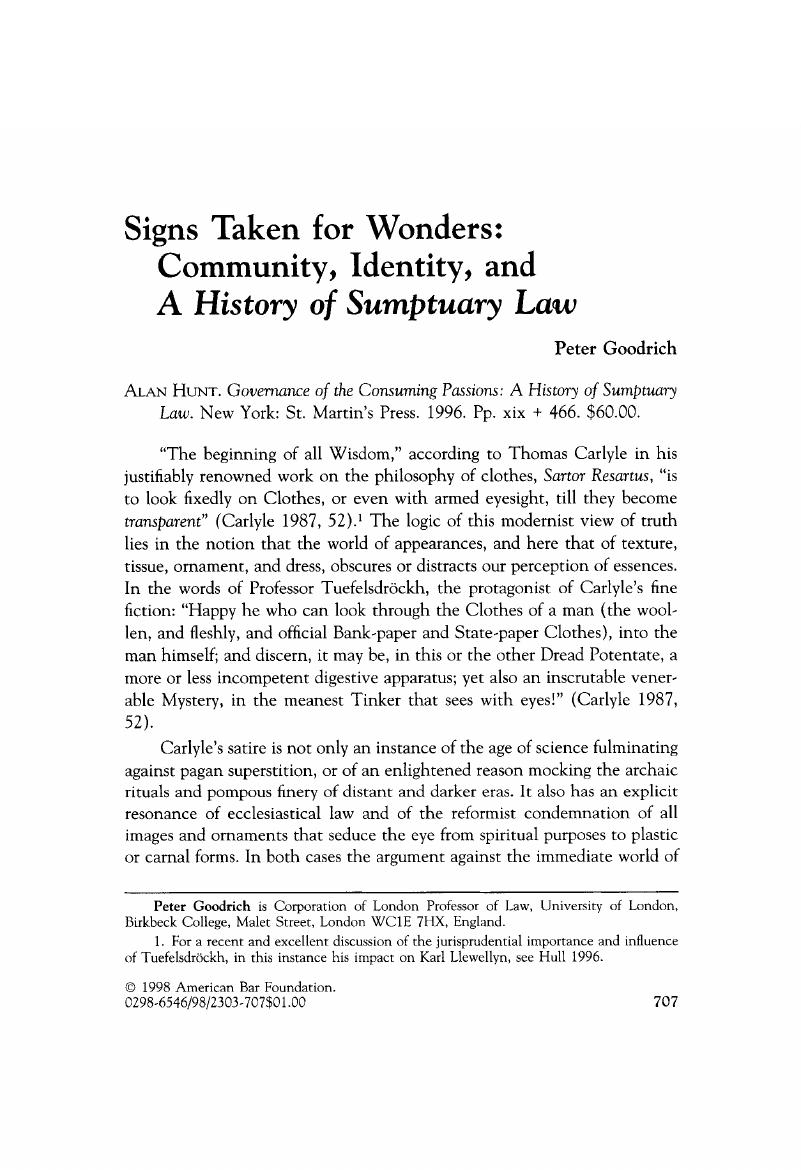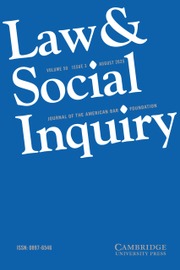No CrossRef data available.
Article contents
Signs Taken for Wonders: Community, Identity, and A History of Sumptuary Law
Published online by Cambridge University Press: 27 December 2018
Abstract
An abstract is not available for this content so a preview has been provided. Please use the Get access link above for information on how to access this content.

- Type
- Review Essay
- Information
- Copyright
- Copyright © American Bar Foundation, 1998
References
Anonymous,
1595. A Glasse to View the Pride of Vainglorious Women: Containing: A Pleasant Invective against the Fantastical Foreigne Toyes, Daylie Used in Womens Apparell. London: Richard Iohnes.Google Scholar
Aston, Margaret. 1988. England's Iconoclasts: Laws against Images. New York: Oxford University Press.Google Scholar
Bartolus of Sassaferato 1485. Tractatus de insigniis et armis. In
Consilia. Venice: N.p.
Google Scholar
Butler, Judith. 1996. The Psychic Life of Power. Stanford, Calif: Stanford University Press.Google Scholar
Court Dress: A Consultation Paper Issued on Behalf of the Lord Chancellor and the Lord Chief Justice. 1993. London: HMSO.Google Scholar
Derrida, Jacques. 1979. The Postcard. From Socrates to Freud and Beyond. Chicago: University of Chicago Press.Google Scholar
Didi-Huberman, Georges
1987. La Couleur de Chair ou le Paradoxe de Tertullien. Nouvelle Revue de Psychanalyse
35:9.Google Scholar
Dilthey, W.
1976. Selected Writings. New York: Cambridge University Press. Downing, Calybute. 1632. A Discourse of the State Ecclesiasticall of this Kingdome in Relation to the Civill Oxford: Turner.Google Scholar
Dugdale, William. 1666. Origines Juridiciales or Historical Memorials of the English Laws. Savoy, England: T. Newcomb.Google Scholar
Eire, Carlos. 1986. War against the Idol: The Reformation of Worship from Erasmus to Calvin. New York: Cambridge University Press.Google Scholar
Estienne, Henri. 1643. The Art of Making Devises: Treating of Hieroglyphicks, Symboles, Emblems, Aenigmes, Sentences, Parables etc. London: J. Holden.Google Scholar
Felman, Shoshona. 1997. Forms of Judicial Blindness, or the Evidence of What Cannot Be Seen: Traumatic Narratives and Legal Repetitions in the O. J. Simpson Case and in Tolstoy's
The Kreutzer Sonata. Critical Inquiry
23:738.Google Scholar
Fortescue, John [1466] 1869.
De Natura legis naturae et de eius censura in successione regnorum supremum
. In The Works of Sir John Fortescue, Knight. London: Private Distribution
Google Scholar
Foucault, Michel. 1991. Governmentality. In The Foucault Effect: Studies in Governmental Rationality, ed. Burchell, G., Gordon, C., and Miller, P.
Hempstead, Hemel England: Harvester Wheatsheaf.Google Scholar
Fox, G.
1655. The Woman Learning in Silence or, the Mysterie of Womans Subjection to Her Husband. London: T. Symmonds.Google Scholar
Garland, David. 1990. Punishment and Modern Society. Chicago: University of Chicago Press.Google Scholar
Goodrich, Peter. 1992. Languages of Law. From Logics of Memory to Nomadic Masks. London: Weidenfeld and Nicolson.Google Scholar
Goodrich, Peter. 1995. Oedipus Lex: Psychoanalysis, History, Law. Berkeley and Los Angeles: University of California Press.Google Scholar
Goodrich, Peter. 1996. Law in the Courts of Love: Literature and Other Minor Jurisprudences. London: Routledge.Google Scholar
Goodrich, Peter. ed. and trans. 1997. Law and the Unconscious: A Legendre Reader. New York: St. Martin's Press.Google Scholar
Guillim, John. 1610. A Display of Heraldry Manifesting a More Easie Access to the Knowledge Therof. London: Roycroft.Google Scholar
Hermer, Joe, and Hunt, Alan. 1996. Official Graffiti of the Everyday. Law B Society. Review 30:455.Google Scholar
Hull, N. E. H.
1996. The Romantic Realist: Art, Literature and the Enduring Legacy of Karl Llewellyn's Jurisprudence. American Journal of Legal History
40:115.Google Scholar
Hunt, Alan. 1991. Marxism, Law, Legal Theory, and Jurisprudence. In Dangerous Supplements: Resistance and Renewal in Jurisprudence, ed. Fitzpatrick, Peter, pp. 102–32. Durham, N.C.: Duke University Press.Google Scholar
Jewel, John. 1564.
An Apologie or Answere in Defence of the Churche of Englande London: n.p.
Google Scholar
Jewel, John. 1567. A Defence of the Apologie of the Churche of England. London: Fleetstreet.Google Scholar
Kantorowicz, Ernest. 1957. The King's Two Bodies. Princeton, N.J: Princeton University Press.Google Scholar
Legendre, Pierre. 1997. The Judge Amongst the Interpreters: Psychoanalysis and Legal Judgment. In Law and the Unconscious: A Legendre Reader, ed. and trans Goodrich, Peter, pp. 164–210. New York: St. Martin's Press.Google Scholar
Legendre, Pierre. 1997. The Masters of Law: A Study of the Dogmatic Function. In Law and the Unconscious: A Legendre Reader, ed. and trans Goodrich, Peter, pp. 98–133. New York: St. Martin's Press.Google Scholar
Logan, John. 1677. Analogia Honorum or a Treatise of Honour and Nobility According to the Laws and Customs of England. London: Roycroft.Google Scholar
Martial, John. 1564. A Treatyse of the Crosse Gathered out of the Scriptures, Councelles and Auncient Fathers of the Primitive Church. Antwerp: I. Latius.Google Scholar
Mondzain, Marie-José
1996. Image, Icône, Economie. Les Sources Byzantines de & lcar; Imaginaire Contemporain. Paris: Seuil.Google Scholar
Murphy, W. Tim
1997. The Oldest Social Science! Configurations of Law and Modernity. Oxford: Clarendon Press.Google Scholar
Parker, Robert. 1607. A Scholasticall Discourse against Symbolizing with Antichrist in Ceremonies. N.p.
Google Scholar
Perkins, William. 1601. A Warning against Idolatrie of the Last Times. Cambridge, England: J. Legat.Google Scholar
Perkins, William. 1609. Christian Oeconomie: Or a Short Survey of the Right Manner of Erecting and Ordering a Familly, According to the Scriptures. Cambridge, England: Cantrell Legge.Google Scholar
Rastall, Master Justice. 1603. A Collection in English, of the Statutes Now in Force. London: T. Wight.Google Scholar
Rastell, John [1526] 1602. An Exposition of Certaine Difficult and Obscure Words, and Terms of the Lawes of this Realme. London: T. Wright.Google Scholar
Roberts, A., and Donaldson, J., eds. 1869. Ante-Nicene Christian Library. Edinburgh, Scotland: T & T Clark.Google Scholar
Rose, Niklas, and Miller, Peter. 1992. Political Power beyond the State: Problematics of Government. British Journal of Sociology
43:172.Google Scholar
Sander, N.
1624. A Treatise of the Images of Christ and of His Saints. Omers, England: Heigham.Google Scholar
Stapleton, Thomas. 1656. A Fortresse of the Faith First Planted Among Us Englishmen, and Continued by the Universal Church of Christ. Antwerp: J. Laet.Google Scholar
Thornton, Margaret. 1996. Dissonance and Dissent. Women and the Legal Profession. Melbourne: Oxford University Press.Google Scholar
Vives, Jan-Luis
1526. A Very Fruteful and Pleasant Boke Called the Instruction of Christen Woman. London: Wykes.Google Scholar
Wayne, Valerie. 1985. Some Sad Sentence: Vives' Instruction of a Christian Woman
. In Silent But for the Word, ed. Margaret, P. Hannay, pp. 15–29. Kent, Ohio: Kent State University Press.Google Scholar




